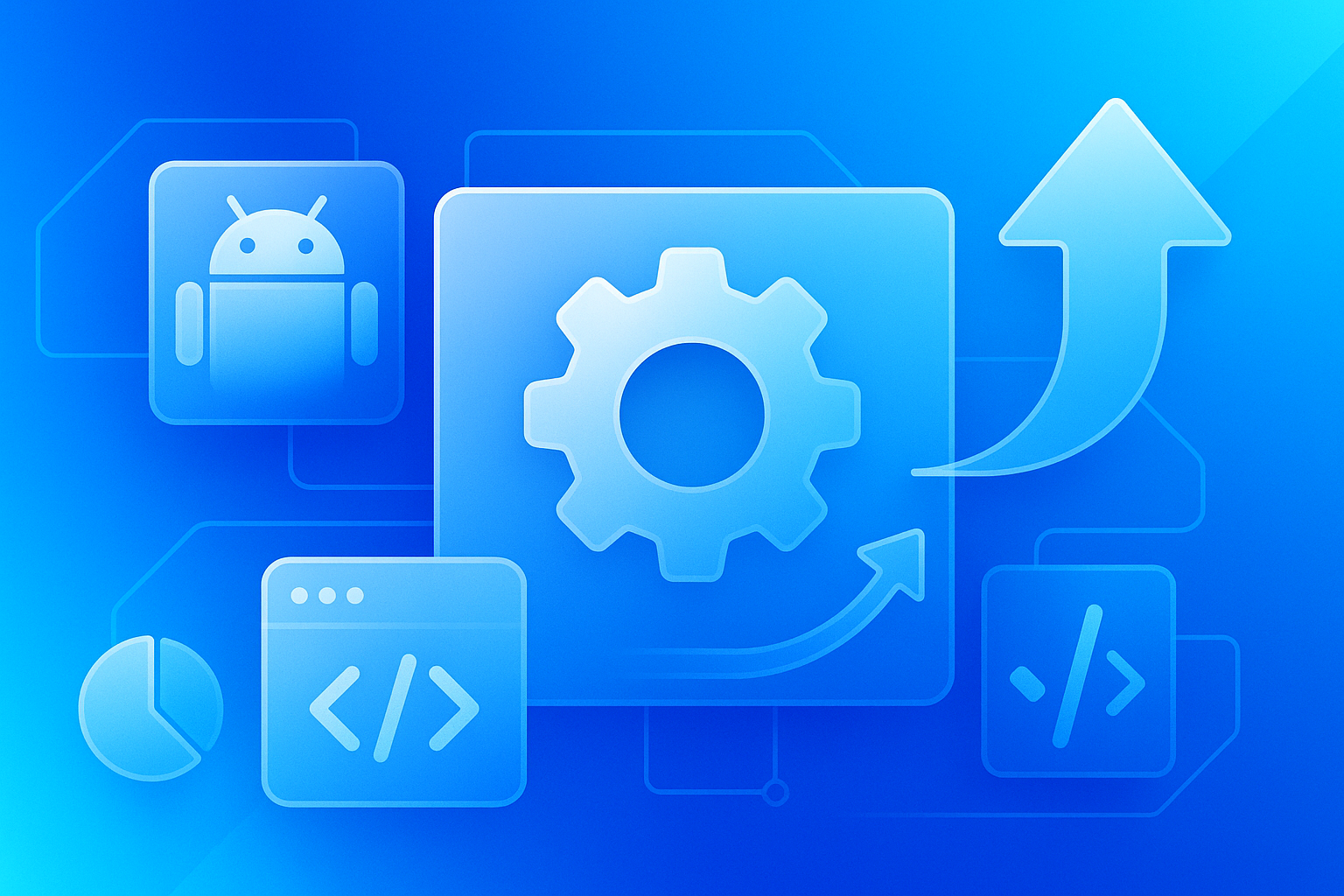Gradle Plugin: How to Automate Your Android Build Process
In the ever-evolving world of Android development, build automation is no longer just a convenience—it’s a necessity. When you’re working on apps with multiple dependencies, flavors, and configurations, manually managing these processes becomes a massive headache. That’s where Gradle enters the picture as a game-changer for developers seeking efficiency.
But here’s what most tutorials won’t tell you: simply using the default Gradle configuration is barely scratching the surface of what’s possible. The real power lies in customization and automation that’s specifically tailored to your workflow. I’ve personally cut build times by over 60% through advanced Gradle optimizations that aren’t commonly discussed in basic tutorials.
Whether you’re a seasoned developer looking to squeeze every millisecond from your build process or a newcomer trying to understand why Gradle has become the industry standard for Android build automation, this comprehensive guide will take you beyond the basics and into the realm of true build process mastery.
TL;DR: Automating Android Builds with Gradle
- Gradle is essential for modern Android development, offering superior flexibility over alternatives like Maven
- The key to efficiency is in customizing your build.gradle files with proper configurations and dependencies
- Create custom tasks to automate repetitive actions in your build workflow
- Implement build caching and parallel execution to dramatically reduce build times
- Setting up proper CI/CD pipelines with Gradle can automate testing and deployment
- Regular maintenance and following best practices prevents common issues that slow down development
Introduction to Gradle Plugin
Remember the days of Ant scripts or manually managing build processes? They seem ancient now, and for good reason. Gradle has revolutionized how we approach Android development by providing a flexible, powerful build automation system that grows with your project.
Gradle emerged around 2012 and quickly gained traction in the Java ecosystem before becoming the official build system for Android in 2013. What makes Gradle special is its unique approach to build automation—it combines the best parts of Ant’s flexibility and Maven’s convention-over-configuration philosophy, while adding its own powerful features through a Groovy-based domain-specific language (DSL).
At its core, a Gradle plugin is essentially a reusable piece of build logic that can be applied to your project. The Android Gradle Plugin (AGP) is the specific implementation that transforms your Android project’s source code, resources, and dependencies into an APK or Android App Bundle. It handles everything from compiling your Java or Kotlin code to processing resources, packaging assets, and signing the final application.
The true power of Gradle lies in automation. Every time you hit that “Build” button, dozens of tasks execute behind the scenes—compiling code, processing resources, running tests, and assembling the final product. Without automation, this would be a manual, error-prone process taking hours instead of minutes or seconds.
According to the Gradle Documentation, projects that implement proper build automation see up to 30% faster development cycles. That’s not just convenience—it’s a competitive advantage in today’s fast-paced development environment.
Why Use Gradle for Android Builds?
Why has Gradle become the de facto standard for Android development? The advantages are numerous and compelling:
- Flexibility: Unlike more rigid build systems, Gradle allows you to define custom build logic tailored to your specific project needs.
- Declarative Builds: You describe what your build should accomplish, not how to do it, making build scripts more maintainable.
- Incremental Builds: Gradle only rebuilds what has changed, dramatically reducing build times for large projects.
- Dependency Management: Advanced dependency resolution handles complex dependency graphs automatically.
- Extensibility: The plugin system allows for easy extension of functionality.
What really sets Gradle apart, though, is its seamless integration with the Android ecosystem. Android Studio ships with Gradle integration out of the box, providing a smooth experience for developers. More importantly, Gradle’s flexibility makes it perfect for complex Android projects with multiple build variants, flavors, and dimensions.
I’ve worked with both Maven and Gradle on complex projects, and the difference is night and day. With Maven, implementing custom build logic often felt like fighting against the system. With Gradle, it feels like the system was designed to accommodate whatever custom build process you need to implement.
This integration extends beyond just the IDE—Gradle works beautifully with CI/CD pipelines like Jenkins, GitHub Actions, and CircleCI, enabling true end-to-end automation from development to deployment.
Setting Up Gradle for Android Build Automation
Before diving into the more advanced aspects of Gradle, let’s ensure you have a solid foundation. Setting up Gradle correctly from the beginning will save you countless headaches down the road.
To get started with Gradle for Android development, you’ll need:
- JDK 8 or higher installed on your system
- Android Studio (which bundles Gradle) or a standalone Gradle installation
- Basic familiarity with Android project structure
If you’re creating a new project in Android Studio, you’re in luck—the IDE handles most of the Gradle setup automatically. However, understanding what’s happening behind the scenes is crucial for effective customization.
When you create a new Android project, Android Studio generates several key Gradle files:
- settings.gradle – Defines which modules are included in your build
- build.gradle (Project level) – Contains build configurations applied to all modules
- build.gradle (Module level) – Contains build configurations specific to each module
- gradle.properties – Contains project-wide Gradle settings
- gradle-wrapper.properties – Specifies which version of Gradle to use
The Gradle Wrapper is particularly important—it ensures that anyone who clones your project uses the same Gradle version, regardless of what’s installed on their system. This consistency is vital for reproducible builds.
For existing projects, you can verify your Gradle setup by running ./gradlew -v (on Linux/Mac) or gradlew.bat -v (on Windows) from the command line. This command should display your current Gradle version.
As per the Android Developers guidelines, it’s recommended to keep your Gradle version updated to benefit from performance improvements and new features, but always check compatibility with your Android Gradle Plugin version.
Configuring Build.gradle Files
The heart of your Gradle configuration lies in the build.gradle files. Understanding their structure is essential for effective automation.
Let’s start with the project-level build.gradle file, which typically looks something like this:
buildscript {
repositories {
google()
mavenCentral()
}
dependencies {
classpath 'com.android.tools.build:gradle:7.0.4'
classpath 'org.jetbrains.kotlin:kotlin-gradle-plugin:1.6.10'
}
}
allprojects {
repositories {
google()
mavenCentral()
}
}
This file defines where Gradle looks for its dependencies (the repositories) and which plugins to apply to your project. The Android Gradle Plugin is the most important one for Android development.
Next, the module-level build.gradle file contains the specific configuration for your app:
plugins {
id 'com.android.application'
id 'kotlin-android'
}
android {
compileSdkVersion 31
defaultConfig {
applicationId "com.example.myapp"
minSdkVersion 21
targetSdkVersion 31
versionCode 1
versionName "1.0"
testInstrumentationRunner "androidx.test.runner.AndroidJUnitRunner"
}
buildTypes {
release {
minifyEnabled true
proguardFiles getDefaultProguardFile('proguard-android-optimize.txt'), 'proguard-rules.pro'
}
debug {
applicationIdSuffix ".debug"
debuggable true
}
}
// Product flavors example
flavorDimensions "version"
productFlavors {
free {
dimension "version"
applicationIdSuffix ".free"
}
paid {
dimension "version"
applicationIdSuffix ".paid"
}
}
}
dependencies {
implementation 'androidx.core:core-ktx:1.7.0'
implementation 'androidx.appcompat:appcompat:1.4.0'
implementation 'com.google.android.material:material:1.4.0'
testImplementation 'junit:junit:4.13.2'
androidTestImplementation 'androidx.test.ext:junit:1.1.3'
}
This file is where you’ll spend most of your configuration time. The key sections include:
- android – Contains all Android-specific configurations
- defaultConfig – Defines the default settings for all build variants
- buildTypes – Configures different build types like debug and release
- productFlavors – Defines different versions of your app (free vs. paid, etc.)
- dependencies – Specifies libraries your app depends on
One powerful feature is the ability to create build variants through combinations of build types and product flavors. For example, with the configuration above, Gradle would generate variants like freeDebug, freeRelease, paidDebug, and paidRelease—each with its own specific configuration.
When setting up dependencies, use pending review time to ensure all dependencies are properly resolved before proceeding with your builds. This helps prevent unexpected errors during the build process.
I remember working on a project where we needed different API endpoints for development, staging, and production environments. By setting up proper build variants with their own buildConfigFields, we could switch environments with a simple selection in Android Studio rather than manually changing code—a huge timesaver that eliminated a common source of errors.
Creating Custom Gradle Tasks
Now that we’ve covered the basics, let’s explore one of Gradle’s most powerful features: custom tasks. These allow you to automate virtually any aspect of your build process.
A task in Gradle represents a single atomic piece of work, such as compiling classes, creating a JAR, or generating Javadoc. The Android Gradle Plugin defines many tasks automatically, but you can create your own to extend functionality.
Here’s a simple example of a custom task that prints a message:
task hello {
doLast {
println 'Hello, World!'
}
}
You can run this task with ./gradlew hello, and it will print “Hello, World!” to the console.
But let’s create something more useful. Here’s a task that automatically increments your app’s version code:
task incrementVersionCode {
doLast {
def propertiesFile = file('version.properties')
Properties props = new Properties()
if (propertiesFile.exists()) {
props.load(new FileInputStream(propertiesFile))
}
def versionCode = (props['VERSION_CODE'] ?: "0").toInteger() + 1
props['VERSION_CODE'] = versionCode.toString()
props.store(propertiesFile.newWriter(), null)
println "Version code incremented to $versionCode"
}
}
This task reads a version number from a properties file, increments it, and writes it back. You could then use this value in your build.gradle:
def loadVersionProps() {
def propertiesFile = file('version.properties')
Properties props = new Properties()
if (propertiesFile.exists()) {
props.load(new FileInputStream(propertiesFile))
}
return props
}
android {
defaultConfig {
// Other configurations...
versionCode loadVersionProps().getProperty('VERSION_CODE', '1').toInteger()
}
}
Tasks can be chained together or made to depend on other tasks. For example, you might want to run the incrementVersionCode task before every release build:
tasks.whenTaskAdded { task ->
if (task.name == 'assembleRelease') {
task.dependsOn incrementVersionCode
}
}
Another practical example is a task to generate release notes based on git commits:
task generateReleaseNotes {
doLast {
def releaseNotesFile = file('release_notes.txt')
def gitLogCmd = 'git log --pretty=format:"%s" -10'
def process = gitLogCmd.execute()
process.waitFor()
releaseNotesFile.text = "Release Notes:\n\n" + process.text
println "Generated release notes at ${releaseNotesFile.absolutePath}"
}
}
Custom tasks are invaluable for automation, especially when service providers help optimize your build process for specific business needs. I’ve used them to automate everything from code generation to deployment notifications.
Advanced Gradle Scripting
As your build automation needs grow, you’ll likely move beyond simple tasks to more advanced scripting. Gradle supports both Groovy and Kotlin DSL for build scripts.
Here’s an example of a more complex task using Groovy to automate screenshot capturing for different device configurations:
task captureScreenshots {
doLast {
def devices = ['Nexus 5', 'Pixel 2', 'Pixel 3 XL']
def languages = ['en-US', 'es-ES', 'fr-FR']
devices.each { device ->
languages.each { language ->
exec {
commandLine 'fastlane', 'screenshot', '--device', device, '--language', language
}
println "Captured screenshots for $device in $language"
}
}
}
}
For more maintainable scripts, especially in large projects, consider creating plugin classes. These allow you to encapsulate build logic in a reusable way:
class VersioningPlugin implements Plugin{ void apply(Project project) { project.task('incrementVersionCode') { doLast { // Implementation here } } } } apply plugin: VersioningPlugin
You can even publish these plugins for reuse across multiple projects using the Gradle Plugin Portal or your own Maven repository.
For organizations with multiple similar Android projects, creating custom plugins is a fantastic way to standardize build processes and enforce best practices across teams. I’ve created plugins that automatically apply our company’s code quality tools, security checks, and deployment procedures—ensuring consistency while reducing the boilerplate each team needs to maintain.
Optimizing Build Processes with Gradle
As your Android project grows, build times can increase dramatically, affecting developer productivity. Fortunately, Gradle offers several powerful optimization techniques.
First, enable the Gradle Daemon, which keeps Gradle running in the background, ready to start builds instantly:
# In gradle.properties org.gradle.daemon=true
Next, leverage parallel execution to utilize multiple CPU cores:
org.gradle.parallel=true
Configure the JVM heap size based on your available memory:
org.gradle.jvmargs=-Xmx4g -XX:MaxPermSize=512m
Enable build caching to reuse task outputs from previous builds:
org.gradle.caching=true
For Android-specific optimizations, consider enabling incremental annotation processing and kapt:
kapt.incremental.apt=true android.enableBuildCache=true
Another powerful technique is to use configuration on demand, which only configures necessary projects:
org.gradle.configureondemand=true
Build optimization isn’t just about Gradle properties. Carefully manage your dependencies to avoid unnecessary inclusions. Use the dependency insight command to analyze your dependency tree:
./gradlew app:dependencies
Look for opportunities to use implementation instead of api for dependencies when possible, as this improves build times by limiting recompilation scope.
Have you considered how your code organization affects build times? Breaking your app into well-defined modules can dramatically improve incremental build performance. When only one module changes, only that module (and its dependents) need to be rebuilt.
These optimizations can make a dramatic difference. On one project, I reduced build times from over 5 minutes to under 1 minute by applying these techniques—a change that saved our team hours of waiting time every day.
Using Gradle in CI/CD Pipelines
One of Gradle’s greatest strengths is its ability to integrate with Continuous Integration and Continuous Deployment (CI/CD) pipelines.
For Jenkins integration, create a Jenkinsfile in your project root:
pipeline {
agent any
stages {
stage('Build') {
steps {
sh './gradlew assembleDebug'
}
}
stage('Test') {
steps {
sh './gradlew testDebug'
}
}
stage('Deploy') {
when {
branch 'release'
}
steps {
sh './gradlew publishReleaseBundle'
}
}
}
}
For GitHub Actions, create a workflow file in .github/workflows:
name: Android CI
on:
push:
branches: [ main ]
pull_request:
branches: [ main ]
jobs:
build:
runs-on: ubuntu-latest
steps:
- uses: actions/checkout@v2
- name: Set up JDK
uses: actions/setup-java@v1
with:
java-version: 11
- name: Cache Gradle packages
uses: actions/cache@v2
with:
path: ~/.gradle/caches
key: ${{ runner.os }}-gradle-${{ hashFiles('**/*.gradle') }}
- name: Build with Gradle
run: ./gradlew build
- name: Run Tests
run: ./gradlew test
When setting up CI/CD, consider these best practices:
- Use the Gradle Wrapper to ensure consistent builds
- Cache dependencies to speed up builds
- Store sensitive information (like signing keys) securely using environment variables or secrets management
- Implement proper test automation at unit, integration, and UI levels
Automated testing is particularly important. Configure your build to run different types of tests:
android {
testOptions {
unitTests.all {
includeAndroidResources = true
}
execution 'ANDROIDX_TEST_ORCHESTRATOR'
}
}
For deployment automation, you can create custom tasks that upload to app stores or distribution services:
task deployToFirebaseAppDistribution {
doLast {
exec {
commandLine 'firebase', 'appdistribution:distribute',
'app/build/outputs/apk/release/app-release.apk',
'--app', project.firebase.appId,
'--groups', 'testers'
}
}
}
If you’re encountering issues with your builds not showing up correctly in CI systems, check out these not showing up troubleshooting tips which can also apply to build visibility issues.
Troubleshooting Common Gradle Issues
Even with careful setup, you’ll inevitably encounter Gradle issues. Here are solutions to the most common problems:
Build Failures with Cryptic Error Messages
When Gradle fails with unclear errors, run with the –stacktrace flag for more details:
./gradlew assembleDebug --stacktrace
Dependency Resolution Conflicts
When libraries have conflicting dependencies, use the following to resolve them:
configurations.all {
resolutionStrategy {
force 'com.google.code.findbugs:jsr305:3.0.2'
// Force specific versions of conflicting dependencies
}
}
Gradle Sync Fails in Android Studio
Try these steps in order:
- File > Invalidate Caches / Restart
- Delete .gradle folder and .idea directory
- Sync with the latest Gradle version compatible with your AGP version
“Could not reserve enough space for object heap” Errors
Increase memory allocation in gradle.properties:
org.gradle.jvmargs=-Xmx4g -XX:MaxPermSize=512m
Slow Builds
Use the –profile flag to identify bottlenecks:
./gradlew assembleDebug --profile
This generates a report in build/reports/profile that shows where time is being spent.
If you’re experiencing issues with your Gradle configuration seemingly disappearing, check these disappeared reasons how to fix which have similar troubleshooting approaches.
I once spent hours debugging a cryptic Gradle error only to discover it was caused by a simple character encoding issue in a properties file. Since then, I always create a clean test project with minimal configuration when facing stubborn issues, then gradually add elements back until I identify the culprit.
Frequently Encountered Problems
Beyond the general issues, there are some specific problems that Android developers frequently encounter:
Gradle Sync Issues in Android Studio
When Android Studio shows the dreaded “Gradle sync failed” message, check:
- Network connectivity for downloading dependencies
- Plugin compatibility between Android Gradle Plugin and Gradle versions
- Repository URLs in your build.gradle files
Out-of-memory Errors During Builds
Large projects with many resources can exceed default memory limits. Solutions include:
- Increasing JVM heap size as mentioned earlier
- Enabling dexing in process:
android.dexOptions.dexInProcess = true - Enabling multidex for development builds
Issues with Gradle Wrapper Configuration
If the Gradle Wrapper is causing problems:
- Run
./gradlew wrapper --gradle-version=7.3.3to update to a specific version - Check gradle-wrapper.properties for correct distribution URL
- Ensure the wrapper has executable permissions on Unix systems
ProGuard/R8 Issues in Release Builds
Code obfuscation can cause runtime crashes if not configured correctly:
- Add -keep rules for libraries that use reflection
- Use the -keepattributes directive to preserve necessary metadata
- Test release builds thoroughly before distribution
One particularly tricky issue I encountered was with library dependencies that had their own transitive ProGuard rules. The solution was to use consumerProguardFiles in our library modules to properly propagate rules up to the app module.
Best Practices for Gradle Configuration
After working with Gradle on numerous Android projects, I’ve developed these best practices to maintain efficient, error-resistant build systems:
Organize Build Scripts Effectively
For large projects, break down your monolithic build.gradle files into smaller, focused scripts:
// In build.gradle apply from: 'gradle/dependencies.gradle' apply from: 'gradle/signing.gradle' apply from: 'gradle/testing.gradle'
This makes your build configuration more maintainable and easier to understand.
Use Version Catalogs for Dependencies
In newer Gradle versions, use version catalogs to centrally manage dependencies:
// In settings.gradle
dependencyResolutionManagement {
versionCatalogs {
libs {
version('kotlin', '1.6.10')
library('kotlin-stdlib', 'org.jetbrains.kotlin', 'kotlin-stdlib').versionRef('kotlin')
library('androidx-core', 'androidx.core:core-ktx:1.7.0')
bundle('kotlin-bundle', ['kotlin-stdlib'])
}
}
}
// In build.gradle
dependencies {
implementation libs.kotlin.stdlib
implementation libs.androidx.core
// Or use bundles
implementation libs.bundles.kotlin.bundle
}
Keep Gradle and Plugins Updated
Regularly update your Gradle version and plugins to benefit from performance improvements and new features. Follow a structured approach:
- First update the Gradle wrapper version
- Then update the Android Gradle Plugin
- Finally update other plugins and dependencies
- Test thoroughly after each step
Use BuildConfig Fields for Configuration
Store environment-specific configuration in BuildConfig fields rather than hardcoding values:
android {
buildTypes {
debug {
buildConfigField "String", "API_BASE_URL", "\"https://api-dev.example.com/\""
}
release {
buildConfigField "String", "API_BASE_URL", "\"https://api.example.com/\""
}
}
}
Follow these tips to optimize for local search when setting up your build processes, as they apply similar optimization principles.
Maintaining and Upgrading Gradle
Keeping your Gradle setup up-to-date is crucial for security, performance, and access to new features. Here’s how to approach it:
Updating Gradle Versions
To update the Gradle wrapper to a newer version:
./gradlew wrapper --gradle-version=7.3.3 --distribution-type=bin
Always check the Gradle release notes for breaking changes before updating.
Migrating from Older Gradle Versions
When making significant version jumps:
- Review the migration guides for each major version you’re skipping
- Update in incremental steps rather than jumping multiple major versions at once
- Test thoroughly after each step
- Pay special attention to deprecated APIs and build features
Keeping Plugins Compatible
Maintain compatibility between your Gradle version and plugins:
- Check the compatibility matrix for Android Gradle Plugin versions
- Use the same major version of Kotlin across all plugins and dependencies
- Test the entire build process after updating any plugin
I once broke our CI pipeline by updating Gradle without checking plugin compatibility. Now I maintain a simple test project that I use to verify version compatibility before updating production projects—a small effort that prevents major disruptions.
Frequently Asked Questions
What is Gradle Plugin?
A Gradle plugin is a reusable piece of build logic that can be applied to your project. The Android Gradle Plugin specifically extends Gradle to handle Android-specific build tasks like packaging APKs, processing resources, and managing Android-specific dependencies. It essentially bridges the gap between Gradle’s build system and Android’s requirements.
How do I automate Android builds with Gradle?
You can automate Android builds with Gradle by configuring your build.gradle files to define build types, product flavors, and custom tasks. For advanced automation, integrate Gradle with CI/CD tools like Jenkins or GitHub Actions, and create custom tasks for repetitive actions such as version incrementing, release note generation, or automated deployment.
What are the benefits of using Gradle for Android builds?
The benefits include faster incremental builds, flexible configuration options, powerful dependency management, ability to create custom build variants, seamless integration with Android Studio, and support for automated testing and deployment. Gradle’s performance features like build caching and parallel execution also significantly reduce build times.
How do I create a custom Gradle task?
Create a custom Gradle task by adding a task definition to your build.gradle file. For example:
task myCustomTask {
group = "Custom Tasks"
description = "This is my custom task"
doLast {
println "Custom task executed!"
// Add your custom logic here
}
}
You can then run it with ./gradlew myCustomTask.
Can Gradle be used for CI/CD pipelines?
Yes, Gradle is excellent for CI/CD pipelines. It provides consistent, reproducible builds thanks to the Gradle Wrapper, supports automated testing at all levels, and can be easily integrated with CI/CD systems like Jenkins, GitHub Actions, CircleCI, and TeamCity. You can create custom tasks for deployment to app stores or distribution platforms.
How do I optimize build speed with Gradle?
Optimize build speed by enabling the Gradle daemon, parallel execution, and build caching in your gradle.properties file. Other techniques include increasing JVM heap size, using configuration on demand, properly structuring your project into modules, using implementation instead of api for dependencies when possible, and keeping your Gradle and plugin versions updated.
What are the best practices for Gradle configuration?
Best practices include organizing build scripts into smaller files for maintainability, using version catalogs for dependency management, keeping Gradle and plugins updated, using BuildConfig fields for environment-specific configuration, properly structuring your project into modules, and leveraging the Gradle Wrapper for consistent builds across different environments.
How do I troubleshoot common Gradle issues?
Troubleshoot Gradle issues by using the –stacktrace and –info flags for more detailed error information, checking for dependency conflicts using the dependencies task, invalidating caches in Android Studio, ensuring proper memory allocation, and verifying compatibility between your Gradle version and the Android Gradle Plugin version.
What is the difference between Gradle and Maven?
Gradle uses a Groovy or Kotlin-based DSL for build scripts, while Maven uses XML. Gradle offers more flexibility and customization options, better performance through incremental builds and build caching, and is better suited for multi-project builds. Maven follows a stricter convention-over-configuration approach. Gradle is the standard for Android development, while Maven is still common in traditional Java projects.
How do I integrate Gradle with Android Studio?
Android Studio comes with Gradle integration built-in. When you create a new project, the IDE automatically sets up the necessary Gradle files. For existing projects, you can import them using the “Import project” option and selecting the build.gradle file. Android Studio provides a Gradle tool window for executing tasks and viewing the project structure based on your Gradle configuration.
Conclusion: Mastering Your Android Build Process
Throughout this guide, we’ve explored how Gradle transforms Android development from a manual, error-prone process into a streamlined, automated workflow. From basic setup to advanced optimization techniques, you now have the knowledge to take control of your build process.
The journey to build automation mastery is iterative—start with the basics, gradually implement custom tasks, optimize performance, and continuously refine your configuration. Each improvement compounds to create a development environment that’s not just faster but more reliable and maintainable.
Remember that effective Gradle configuration is about more than just speed—it’s about creating a consistent experience across your team, enabling CI/CD workflows, and ultimately delivering better apps to your users.
What will you automate first? Perhaps start with a simple custom task to solve a recurring pain point in your workflow, then expand from there. The possibilities are virtually limitless, and even small improvements can yield significant benefits over time.
Take action today: review your current Gradle configuration, identify bottlenecks, and implement at least one optimization technique from this guide. Your future self (and your team) will thank you for the time saved and frustration avoided.









